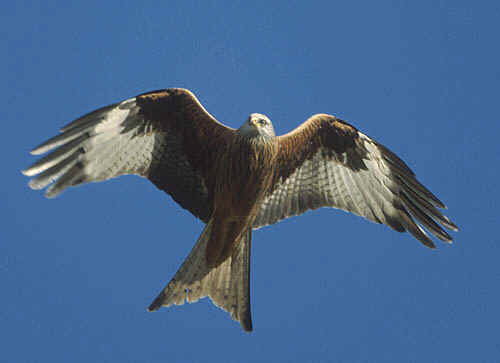 SWEDEN
BIRDS
SWEDEN
BIRDS
during Focus On Nature Tours
1996 thru 2014
From 1996 to 2002, this
tour was
during
the first week of October.
After that, it has been during the
last week in September.
The following list
compiled by Armas Hill
Photo at right: RED KITE
The following is a
cumulative list of the birds that have been found
during FONT
tours in southern Sweden, totaling 179 species.
With this tour, it's not so much a big
number of species, as it is a big number of birds, during a
spectacular migration.
Swedish
bird-names follow the English names in the first line.
Codes:
(i): introduced in Europe
(t): a globally threatened or
rare species, designated by Birdlife International
(t1): critical
(t2): endangered
(t3): vulnerable
(nt): a near-threatened species
globally
(ph: species with a photo in the FONT website
(SWr): rare in Sweden
FS: in the area of Falsterbo & Skanor in far-southern Sweden
OL: on Oland Island, in the Baltic, off the coast of southeast
Sweden
sep: in September
oct: in October
Links:
Upcoming FONT Birding & Nature Tours in Sweden
FONT Past Tour
Highlights
A Bird-List & Photo Gallery of European Birds, in 2 parts:
Part #1: Grouse to Puffin Part #2:
Sandgrouse to Buntings
A
Feature of Photos from a Previous FONT Sweden Tour
Mammals & Some Other
Wildlife of Sweden
Directory
of Photos in this Website

Bird-List:
- Western Capercaille
(Tjader)
______
Tetrao u. urogallus
- Grey Partridge (Rapphöna) ______ OI
sep
Perdix p. perdix
- Common Pheasant (Fasan) ______ FS OI sep
Pasianus colchicus
- Mute Swan (Knölsvan) (ph) ______ FS OI sep
Cygnus olor (monotypic)
- Whooper Swan (Sångsvan)
(ph) ______
Cygnus cygnus
(monotypic)
- "Bewick's" Tundra
Swan (Mindre
sångsvan) ______
Cygnus columbianus bewickii
- Greylag Goose (Grågås)
(ph) ______ FS OI sep
Anser a. anser
- Bean Goose (Sädgås) ______
Anser fabilis
- Greater White-fronted Goose
(Bläsgås) ______ OI sep
Anser a. albifrons
- Brant Goose (Prutgås)
(ph) ______ OI sep
(has been called
Brent Goose in Europe)
Branta b. bernicla
- Barnacle Goose (Vitkindad
gås) (ph) ______
FS OI sep
Branta leucopsis (monotypic)
- Canada Goose (i) (Kanadagås) ______ FS OI sep
Branta canadensis
- Red-breasted Goose (t3) (Rödhalsad gås)
(ph) ______ OI
Branta ruficollis (monotypic)
- Egyptian Goose (i) (SWr) (Nilgas)
______ OI sep (1 during FONT tour in 2007)
Alopochen aegyptiaca (monotypic,
and the single member of its genus)
- Common Shelduck
(Gravand) ______ FS OI
Tadorna tadorna (monotypic)
- Mallard (Gräsand)
(ph) ______ FS OI sep
Anas p. platyrhynchos
- Gadwall (Snatterand)
(ph)
______ FS OI sep
Anas strepera (monotypic)
- Eurasian Wigeon (Bläsand)
(ph) ______ FS OI sep
Anas penelope
(monotypic)
- Eurasian Teal (Kricka) ______ OI
Anas c. crecca
- Northern Pintail
(Stjärtand)
(ph) ______ FS OI sep
Anas acuta (monotypic)
- Northern Shoveler (Skedand)
(ph) ______ FS OI sep
Anas clypeata (monotypic)
- Common Pochard (Brunand) (ph) ______ FS sep
Aythya ferina (monotypic)
- Tufted Duck (Vigg) ______ FS OI sep
Aythya fuligula (monotypic)
- Greater Scaup (Bergand) ______ FS sep
Aythya m. marila
- Common Eider (Ejder)
(ph) ______ FS OI sep
Somateria m. mollissima
- Steller's Eider (Alforradare)
(ph) ______ OI sep (1 during FONT tour in 2006)
Polysticta stelleri (monotypic, and the single
member of its genus)
- Velvet Scoter (t2)
(Swärta) ______
(was
conspecific with the White-winged Scoter of North America
& eastern Asia)
Melanitta fusca
- Common Goldeneye
(Knipa) ______ FS OI sep
Bucephala c. clangula
- Common Merganser
(Storskrake)
(ph) ______
(has
been called
Goosander
in Europe)
Mergus m. merganser
- Red-breasted Merganser
(Småskrake)
(ph) ______ FS OI sep
Mergus serrator (monotypic)
- Red-throated Loon (Smalom)
(ph) ______
FS sep (has been called Red-throated Diver
in Europe)
Gavia stellata
(monotypic)
- Black-throated Loon
(Storlom)
(Ev) ______ OI sep (has been called
Black-throated Diver
in Europe, and
Arctic Loon
in North America)
Gavia a. arctica
- Northern Fulmar
(Stormfågel)
(ph) ______
Fulmarus glacialis auduboni
- Great Crested Grebe (Skäggdopping) ______ FS OI sep
Podiceps c. cristatus
- Red-necked Grebe
(Gråhakedopping)
(ph) ______
Podiceps g. grisegena
- Horned Grebe
(Svarthakedopping) (ph) ______
OI sep
(has been called Slavonian Grebe
in
Europe)
Podiceps a. auritus
- Little Grebe ("Dabchick") (Smådopping)
(ph) ______ FS OI sep
Tachybaptus r. ruficollis
- Grey Heron (Häger)
(ph) ______ FS OI sep
Ardea c. cinerea
- Great Egret (SWr) (Ägretthäger)
(ph) ______
Ardea a. alba
- Great Cormorant (Storskarv) ______ FS OI sep
Phalacrocorax c. carbo
- Peregrine Falcon (Pilgrimsfalk)
(ph) ______ OI sep
Falco p. peregrinus
- Eurasian Hobby (Lärkfalk) ______ FS OI sep
Falco s. subbuteo
- Merlin (Stenfalk)
(ph) ______ OI sep
Falco columbarius aesalon
- Eurasian Kestrel
(Tornfalk) ______ FS OI sep
Falco t. tinnunculus
- Osprey (Fiskgjuse)
(ph) ______
Pandion h. haliaetus
(the single member of its genus)
- White-tailed Eagle (nt) (Havsörn)
(ph) ______ FS OI sep (has
also been called
White-tailed Fish-Eagle)
Haliaeetus a. albicilla
- Red Kite (Rod Glada) (ph) ______ FS sep
Milvus m. milvus
- Black Kite (Brun Glada)
______ FS sep
Milvus m. migrans
- Eurasian Sparrowhawk
(Sparvhök)
(ph) ______ FS OI sep
Accipiter n. nisus
- Northern Goshawk (Duvhök) ______ FS OI sep
Accipiter g. gentilis
- Common Buzzard (Ormvråk)
(ph) ______ FS OI sep
Buteo b. buteo
- Rough-legged Buzzard (Fjällvråk)
(ph) ______ FS
(called
Rough-legged Hawk in
North America)
Buteo l. lagopus
- European Honey Buzzard
(Bivråk) ______ FS sep
Pernis apivorus (monotypic)
- Golden Eagle (Kungsörn) ______
Aquila c. chrysaetos
- Greater Spotted Eagle (t3) (SWr)
(Större skrikörn) ______
Aquila clanga
(monotypic)
- Lesser Spotted Eagle (SWr)
(Mindre
skrikörn) ______
OI sep
Aquila p. pomarina
- Western Marsh Harrier
(Brun kärrhök) ______
FS OI sep
(was conspecific with what's now the
Eastern Marsh Harrier)
Circus aeruginosus
- Hen Harrier (Blå kärrhök) ______ FS OI
sep (in
North America, the Northern Harrier
was formerly conspecific)
Circus cyaneus
- Water Rail (Vattenrall)
______
Rallus a. aquaticus
- Spotted Crake
(Småfläckig sumphöna) (ph) ______
FS


 SWEDEN
BIRDS
SWEDEN
BIRDS 
![]()